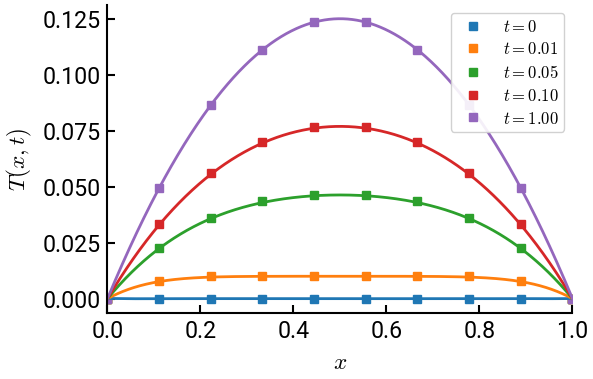13. Time-dependent heat equation#
Now that we have some experience solving for the steady-state temperature distribution, it’s time to return to time-dependent behavior.
Summary of commands#
In this exercise, we will apply several of the commands we’ve already learned!
Heat in a wire#
Heat generated from an electric wire is defined by the time-dependent heat equation:
with \(u(0,t) = u(L,t) = 0\) and \(u(x,0) = 0\).
Use the discretization scheme \(u_i^{n+1} = u_i^n + \dfrac{\lambda^2 dt}{h^2} \left( u_{i-1}^n - 2u_i^n + u_{i+1}^n \right) + q \cdot dt \) with \(N = 10\), \(L = 1\), \(\lambda = 1\), and \(q = 1\) to find the temperature distribution at \(t = \begin{bmatrix} 0 & 0.01 & 0.05 & 0.1 & 1 \end{bmatrix}\). Take \(dt = 0.005\).
The analytical solution for this problem through Fourier series is
Plot the analytical solution at the same time steps using the first \(10\) partial sums and compare the two graphs.
# import libraries
import numpy as np
import matplotlib.pyplot as plt
# initialize
N = 10
lamda = 1 # we misspell because 'lambda' is a reserved keyword in Python
L = 1
q = 1
h = L / (N - 1)
dt = 0.005
t = np.array([0, 0.01, 0.05, 0.1, 1])
x = np.linspace(0, L, N)
u = np.zeros(N)
# plot initial
fig, ax = plt.subplots()
ax.plot(x, u, 's', ms=6, label="$t = 0$")
ax.set(xlabel='$x$', ylabel="$T(x,t)$", xlim=[0,1])
# discretized solution - plot as squares
for j in range(1, int(t[-1]/dt) + 1):
u_old = u.copy()
for i in range(1, N - 1):
u[i] = u_old[i] + lamda**2 * dt / h**2 * (u_old[i-1] - 2 * u_old[i] + u_old[i+1]) + q * dt
if j * dt in t:
ax.plot(x, u, 's', ms=6, label=f"$t = {j * dt:.2f}$")
# analytical solution
nmax = 19
x = np.linspace(0, L, 1000)
# plot analytical solution as curves
for k,tt in enumerate(t):
T = -q * x**2 /2 + q * L * x /2
for n in range(1, nmax+1, 2):
T -= 4 * L**2 * q / (n**3 * np.pi**3) * np.sin(n * np.pi * x / L) * \
np.exp(-n**2 * np.pi**2 * tt / L**2)
ax.plot(x, T, lw=2, c=f"C{k}")
ax.legend(fontsize=12, framealpha=0.9)
plt.show()


